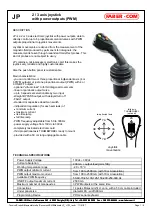
3.4 Display–Alarm Indication
The IQT display incorporates valve,
control system, actuator and battery
alarm indication in the form of four
display icons. Located in the top portion
of the display, each icon represents
certain alarm conditions. Standard help
screens are also available to assist in
determining the actuator operational
and alarm status
(refer to Help Screens
page 64).
Valve Alarm
Fig. 3.6
The valve alarm icon, Fig 3.6, is
displayed when a valve problem causes
the actuator to “trip-off’’ due to the
configured torque value being
developed
(refer to
[tC]
/
[tO]
pages
20/21)
.The possible causes are:
• Valve tight or obstructed in mid travel.
• Valve stuck or jammed
• Valve process conditions changed
(increase in pressure, flow etc.)
Once the actuator has tripped off on
torque, electrical operation in the same
direction is inhibited. The icon will
remain displayed until movement in the
opposite direction takes place.
The valve alarm icon will not be
displayed when stopping at end of
travel for valves configured to torque
seat or torque back seat at end of
travel
(refer to
[C2]
/
[C3]
pages 18/19).
Try handwheel operation of the valve to
‘‘feel’’ for stiffness (refer to page 3).
Control Alarm
Fig. 3.7
The control system alarm icon, Fig 3.7,
is displayed when the remote control
system maintains an active ESD or
interlock signal (the ESD, interlock
function or conditional control having
been enabled.)
Local and Remote operation will be
inhibited while an active ESD or
interlock signal is present
(refer to
[A1]
ESD Action page 30,
[A8]
External
Interlocks page 32 and Conditional
Control
[A9]
page 32.)
Investigate the operational conditions
of the actuator remote control system.
5










































